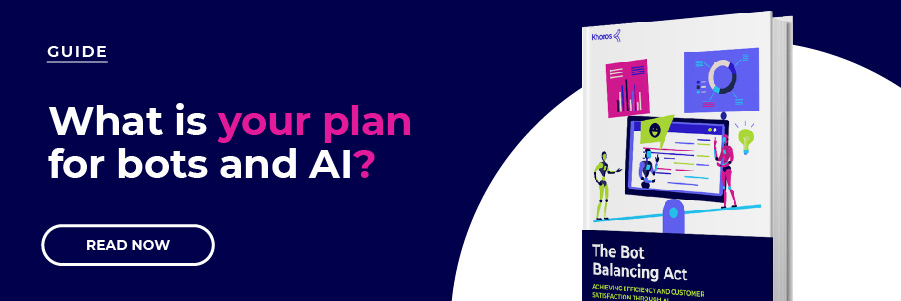 Logo
Logo
EXPERT INSIGHTS
May-28-2020
Chatbot statistics to guide customer care in 2020
Jackson Kushner
Chatbots, which are artificial intelligence systems that interact with users through messaging, expand business’ ability to provide timely and efficient customer support. The benefits of using chatbots are extensive: automated workflows, increased resolution rate for consumer inquiries, and useful data gathering, to name a few.

While savvy digital customer care has become commonplace for enterprises, there’s still a large percentage of businesses struggling to provide the level of support that consumers expect. The reasons are two-fold:
- Effective chatbots require advanced capabilities to manage a large volume of diverse messages.
- An on-demand culture breeds continually-increasing consumer expectations.
Businesses that currently use chatbots need to take stock to ensure their support is up to par. And for businesses that don’t already use chatbots, escalating reliance on them by consumers will make it difficult to hold out for much longer.
Understanding the current state and capabilities of chatbots, as well as consumer expectations for them, is crucial. That’s why we’ve rounded up the most relevant chatbot statistics that customer care teams need to know today. The following information helps inform businesses as they continue to manage more of their sales, customer service, and general communication online.
Businesses’ reliance on chatbots is continuing to grow
It’s projected that the market size of chatbots will grow from $2.6 billion in 2019 to $9.4 billion by 20247

Source: Business Insider and ResearchAndMarkets.com
Chatbots aren’t just for ecommerce. The rise of chatbot usage is a direct result of consumers demanding round-the-clock service in a wide range of industries, including banking and finance, and healthcare, as well as online shopping.
59% of entrepreneurs with online businesses say the primary reason for setting up chatbots is to get answers for visitors quickly10
The ability to respond quickly to customers is a universal benefit for most businesses. The size of an operation can pose different challenges: Small businesses might not have the manpower to stop what they’re doing to respond to customers in real-time, whereas enterprise-level businesses must manage a large volume of consistent requests. Chatbots provide a solution in both of these cases.
The use of chatbots for customer service and payment processing can reduce operational costs by up to 30%8
Automated responses enable customer care teams to spend less time with standard questions and more capacity to tackle issues requiring human interaction:
- Chatbots can answer 80% of standard questions8
- 64% of customer support agents who use chatbots can spend more of their time solving complex problems12
- By the end of 2023, companies will save an estimated 2.5 billion hours on customer service by using chatbots1
50% of business owners perceive chatbots as a high barrier of entry, saying they don’t use them because they don’t know how10
Using chatbots can be intimidating for some business owners, especially for those at the helm of legacy enterprises that don’t do a majority of their business online for. But with a reliable chatbot software, implementation processes are largely built-in and easy to customize.
Reaching customer support via chatbots has become the norm for most people
Approximately 1.4 billion people are willing to use chatbots11
When chatbots first were created, many viewed them simply as a novelty. As software has improved, however, more businesses are grasping the possibilities of using chatbots, and customers are coming not only to accept, but to expect them.
In the past year, 67% of online consumers worldwide used chatbots for customer support9
Among the many reasons for consumers to communicate via a chatbot, these were cites as the main motivations:4
- 35% of consumers say they would use a chatbot to air a complaint, resolve a problem, or for explanations
- 64% of internet users say that 24-hour service is the best feature of chatbots
Consumers want to chat, and bots can often do the job
53% of consumers are more likely to shop with a business that they can also message3
In addition to round-the-clock customer service, a majority of consumers prefer not having to stop what they’re doing to make a phone call. In fact, 56% of people would rather message than call customer service. This raises the question of who should be on the other end of that chat: a person or a bot? Finding the answer isn’t always easy. 53% of consumers don’t care whether a chatbot or a human solves their issue, as long as it gets solved. Chatbots have proven themselves to be capable of handling simple inquiries, and many inquiries fall under this category. This means that chatbots are an easy way to improve customer satisfaction — and just as importantly, gain customers — without expanding a contact center. Still, customers do prefer humans to help them with more complex inquiries.
Quality matters: 47% of internet users in the U.S. feel that chatbots provide too many unhelpful responses2
Even though chatbots are capable of handling many simple inquiries, sometimes they’re not enough. If your chatbot software provides canned responses that are vague or lack next steps, the user’s experience can be extremely frustrating. Even worse, if there isn’t a way to easily escalate conversations to speak with a human customer support representative, consumers can be left feeling like there’s no way to get the help they need.
Consumers expect quick response times when using chat — either with a human or chatbot
70% of consumers expect a response within minutes on chat5
Of all communication channels, chat has the highest expectation for speedy response times.

For many consumers, chat has been sold to them as a way to speak with a customer service representative — or at least get help to resolve their issue — quickly. If that expectation isn’t met, it defeats the purpose. And brands fail to meet this expectation more often than you might think; in most industries, consumers that use chatbots to reach customer support have to wait as long as 24 hours to hear back nearly 25% of the time.10
Slow response times are common across many industries:10
- 24.7% of chatbot conversations in the accommodations industry take 1-24 hours to receive an initial response
- 25.7% of chatbot conversations in the beauty & wellness industry take 1-24 hours to receive an initial response
- 25.1% of chatbot conversations in the finance industry take 1-24 hours to receive an initial response
- 24.6% of chatbot conversations in online stores take 1-24 hours to receive an initial response
- 23.8% of chatbot conversations in the real estate industry take 1-24 hours to receive an initial response
- 20.1% of chatbot conversations in the services industry take 1-24 hours to receive an initial response
68% of consumers are very or extremely frustrated when a chat session ends without resolution5
Regardless of the amount of time it takes for an initial response, customers expect their issue to be resolved. When this doesn’t happen, it puts a bad taste in consumers’ mouths and decreases the likelihood that they will use that business again.

Most traditional chat solutions are synchronous, which means that sessions will time out and end if the customer isn’t responding quickly enough. This creates frustrated customers. While the best solution to this problem is to migrate to a modern, asynchronous chat solution, chatbots can also help keep customers engaged and route them to a human agent if and when they need it to ensure their issue is resolved.
Leveraging software to go beyond simply providing chatbot capabilities — and doing it well
Providing efficient and, above all, helpful chatbot messaging to your customers requires software that creates a good experience for them as well as support teams. Khoros Care equips businesses with advanced messaging capabilities, such as chatbots and asynchronous chat, to bring conversations across multiple channels to create a seamless experience. Teams that can leverage the best of automation and also human interaction are extremely well positioned to create an experience for customers that makes them feel taken care of, quickly and thoughtfully. Contact us for a free demo today.
References
- Abbas, Aslam. “Chatbot 2019 Trends and Stats with Insider Reports.” ChatBotsLife, 12 February 2019.
- Clement, J. “Challenges of using chatbots according to U.S. internet users 2018.” Statista, 09 October 2018.
- Digitalgo. “Socializing with AI – Chatbot Stats 2018.” 13 August 2018.
- Drift. “The Chatbot Learning Center.”
- Khoros. “Give people what they want: Modern web chat.” 29 April, 2020.
- Khoros. “Man vs. Machine: Consumer perceptions of chatbots.” 30 April, 2020.
- Nguyen, Mai-Hanh. “The latest market research, trends, and landscape in the growing AI chatbot industry.” Business Insider, 23 January 2020.
- Reddy, Trips. “How chatbots can help reduce customer service costs by 30%.” IBM: Watson Blog, 17 October 2017.
- Shukairy, Ayat. “Chatbots In Customer Service – Statistics and Trends [Infographic].” Invesp, 09 May, 2018.
- Sienkiewicz, Agnieszka. “11 Amazing Chatbots Statistics and Trends You Need to Know in 2020.” Tidio, 8 May 2020.
- Suthar, Sam. “11 Chatbot Trends that Help Grow Your Business.” Acquire, 05 June 2020.
- Sweezey, Matthew. “Key Chatbot Statistics to Know in 2019.” Salesforce, 04 August 2019.











